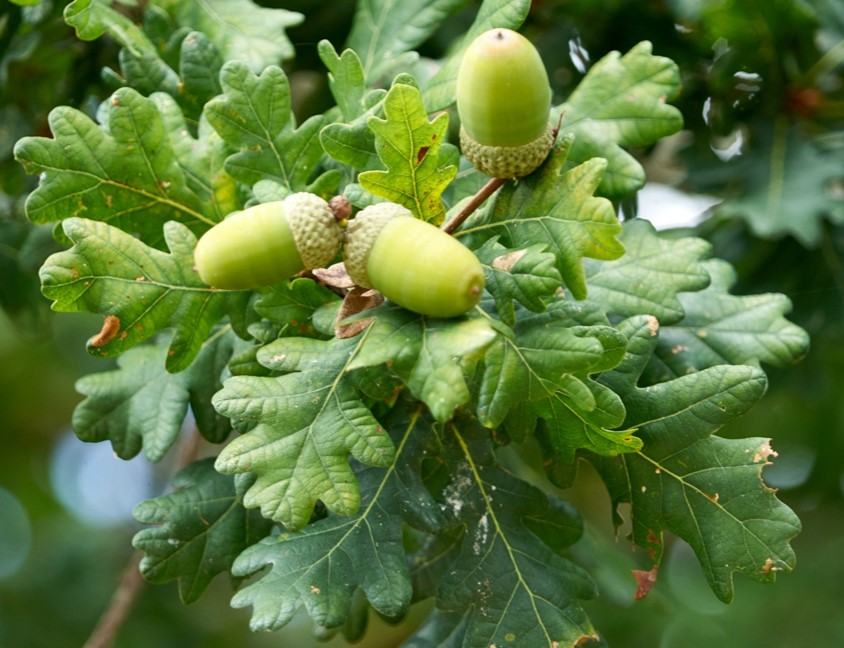3. Plant-based pharmaceuticals
In this book you will learn about the different groups of active ingredients and procedures.
3.1 Groups of active ingredients
Terpenes
Terpenes or terpenoids can have very different structures, but are very characteristic of the respective plant. The term terpene covers a wide range of substances, but they are all based on the molecule isoprene (C5H8), which is converted into the activated form isopentenyl diphosphate by incorporating phosphate.
The above-mentioned taxol used to combat cancer from the Pacific yew belongs to the terpene group, as does rubber, which has important technical and economic significance.

Terpenes are basically hydrocarbons with characteristic functional groups and chemically belong to the lipids.
Terpenes are divided into hemi- (C5), mono- (C10), sesqui- (C15), diterpenes (C20), etc. based on the C-atoms they contain. If there are more than 40 C atoms, they are referred to as polyterpenes.
| From | Substance | Occurence | Effect/Use |
| Monoterpene | Pines | Conifers | Turpentine / rosin |
| Sesquiterpene | Curcumene | Tumeric | Spice, good for digestive track |
| Diterpene | Taxol | Pacific yew | Cancer medication |
| Triterpene | Limonoide | Citrus fruits | Prevention of cancer, potentially lowering cholesterol |
| Tetraterpene | Carotinoids | Carrots | Strengthening immune system and sight |
| Polyterpene | cis-Polyisoprene | Rubber tree | Rubber |
Plants synthesize terpenes for a wide variety of applications:
- to repel predators (antimicrobial)
- to attract pollinators (odorants and flavorings)
- as signalling substances, growth regulators (phytohormones)
It is also interesting to note that some insects absorb plant terpenes and synthesize pheromones (signaling substances) from them, which they can use to attract or warn conspecifics.
Essential oils
Essential oils mostly consist of mono- and sesquiterpenes and form their own diverse subgroup of terpenes with a wide variety of medicinal effects. Essential oils have a characteristic, strong smell and taste, are oily but still very volatile. They are not readily soluble in water, forming a film on the water surface, but dissolve in lipophilic solvents (benzene, ethanol, fatty oils). Under the influence of light or oxygen, the essential oils change and lose their quality and taste.
Essential oils play a role in all smelling or fragrant parts of plants. They attract insects or protect the plant from predators, microorganisms or fungi.
Volatile essential oils are obtained by steam distillation. Less volatile essential oils are extracted by pressing, supercritical CO₂ or solvents. Essential oils can be used in a variety of ways as ointments, teas, rinses, tinctures or herbal seasonings. Depending on their origin, they promote circulation, stimulate appetite and digestion, have an antiseptic, calming, expectorant or anti-inflammatory effect.
| Essential oil | Effect |
| Anis oil | Simulates appetite and digestion |
| Citrus oils | Mood-lifting, stimulating |
| Eucalyptus oil | Antiseptic, antimicrobial |
| Camomile oil | Anit-inflammatory |
| Camphor oil | Stimulates blood ciculation |
| Lavender oil | Calming |
| Mentol | Disinfectant, cooling |
| Peppermint oil | Simulates appetite and digestion |
| Rosemary oil | Stimulates blood ciculation |
| Sage oil | Antiseptic |
| Thyme oil | Stimulates expectoration |
Phenolic compounds
The group of phenols or phenylpropanoids are very diverse and serve the plant both as a defense against predators or pathogens (tannins, phytoalexins), as well as to attract pollinators or seed dispersers (dyes) and to build supporting structures (lignin). The starting point for the synthesis of plant phenols is the amino acid phenylalanine.
The most important substance groups and their occurrence are described in more detail below.
Flavonoids (colorants)
The term flavonoids is derived from the Latin word for yellow “flavus”. Many colorants extracted from plants in the past (e.g. from the dyer's woad) were yellow. But other flower dyes (reddish, violet, bluish) also belong to the flavonoids. They also provide the plant with UV protection. Medicinally effective flavonoids are usually bound to sugars and are then referred to as glycosides. Many fruits and vegetables contain flavonoids. They are said to have a health-promoting, antioxidant, anti-carcinogenic and radical-scavenging effect.
Flavonoids are found in
- local fruit varieties (e.g. apples, pears, berries, cherries)
- onions, eggplants
- Tea, cocoa and red wine
Red vine leaves, for example, contain quercitrin and rutin, which have an anti-inflammatory and vascular-sealing effect and are therefore used to treat swollen legs.
Phytoalexins
Phytoalexins can also be classified as flavonoids, but can also be formed from other substance classes and should therefore be presented separately. In contrast to the dyes, they fulfill a completely opposite task. They serve as a defense against pathogenic fungi or bacteria. It is interesting to note that these substances are only produced after the plant has been infected and do not occur in healthy plants. Phytoalexins are designed to inhibit the spread or multiplication of harmful invaders. The phytoalexins can be detected in the infected plant parts after just 24 hours. Research into this is still relatively new.
Tannins (tannins)
Tannins are polyphenols and have both technical and medicinal significance. Tannins precipitate proteins and are therefore used in the production of leather from animal hides. Nowadays, however, synthetic tanning agents are mostly used in industry. Plants produce tannins to keep predators away. They are found in wood and bark (e.g. oak), but also in leaves and sometimes in fruit. Tannins have an antibacterial or antiviral effect and therefore have preservative properties. As they react with protein molecules, tannins have an astringent effect, i.e. they contract, which is used to treat diarrhea, increased sweating or inflammation.

Lignin
Lignin also belongs to the group of complex phenolic compounds (phenylpropanoids). They lead to the lignification of the plant cell wall and thus serve to increase the compressive strength. The technical use of lignins is currently still being researched, as lignins usually have to be laboriously separated from the wood for paper production or biofuel production, for example, and are then mainly used for energy.
The article by Rinaldi et al. (2016) offers a deeper insight into the state of research on better utilization of lignin:
https://doi.org/10.1002/ange.201510351

Alkaloids
Alkaloids are based on nitrogen-containing compounds. Most of them have a very strong effect on the central nervous system and are often toxic. Prominent representatives of this very extensive group of substances are caffeine, nicotine, cocaine, morphine, quinine or atropine (in belladonna). 12,000 alkaloids have been researched. The plant forms alkaloids in the amino acid metabolism and thus protects itself from predators. Each plant family produces a typical substance and only forms it in certain life stages or parts of the plant. This is why plants such as potatoes, tomatoes and peppers, which often belong to the nightshade family and produce alkaloids, are nevertheless important edible plants. In the consumed parts of these plants, the alkaloid is broken down with increasing maturity or disappears at the latest through preparation (peeling, cooking). In some cases, people deliberately accept the slightly toxic but stimulating effect. Tobacco, for example, also belongs to the nightshade family.
| Substance | Occurence | Effect/Use |
| Morphin | Opium poppy (Papaver somniferum) | Painkiller |
| Colchicine | Autumn crocus (Colchicum autumnale) | gout medicine |
| Atropine | Belladonna (Atropa belladonna), datura (Datura stramonium); angel's trumpet (Brugmansia) | ophthalmology (dilated pupils), antidote to pesticides or neurotoxins, anesthesia |
| Theobromine | Aca tree (Theobroma), cola nut (Cola acuminata) | stimulating, mood-enhancing |
| Capsaicin | Paprika/chilli (Capsicum) | antibiotic, increases blood circulation, against muscle pain and tension, “pepper spray” |
| Quinine | Yellow cinchona (Cinchona officialis) | malaria treatment |
| Ergotamine | Mother horn mushroom (Claviceps purpurea) | migraine and severe headaches (production of the drug LSD) |
| Strychnine | Nux vomica (Strychnos nuxvomica) | highly toxic, stimulating effect, causes cramps in high doses, used for homeopathic medicines, rat poison, doping) |